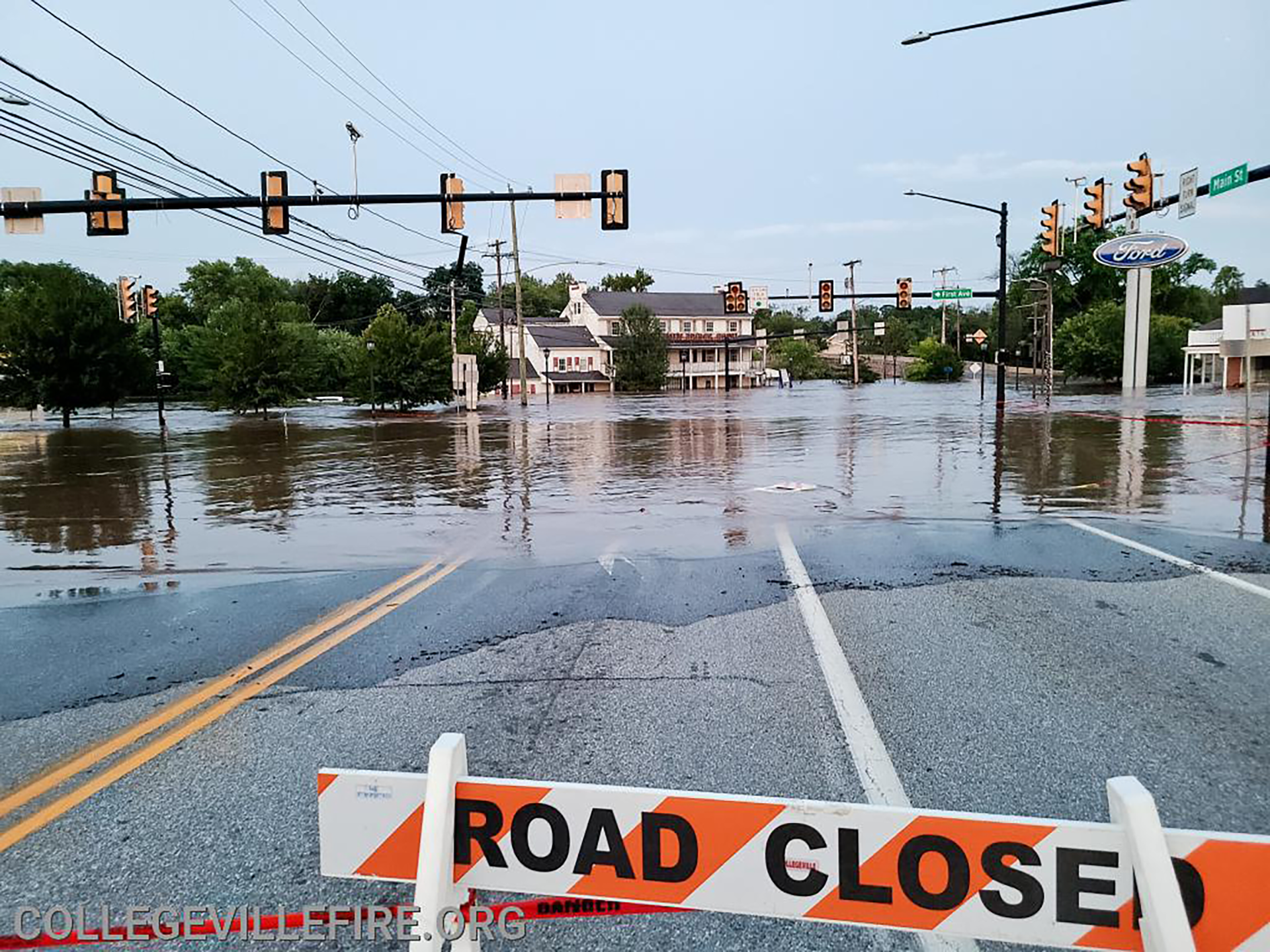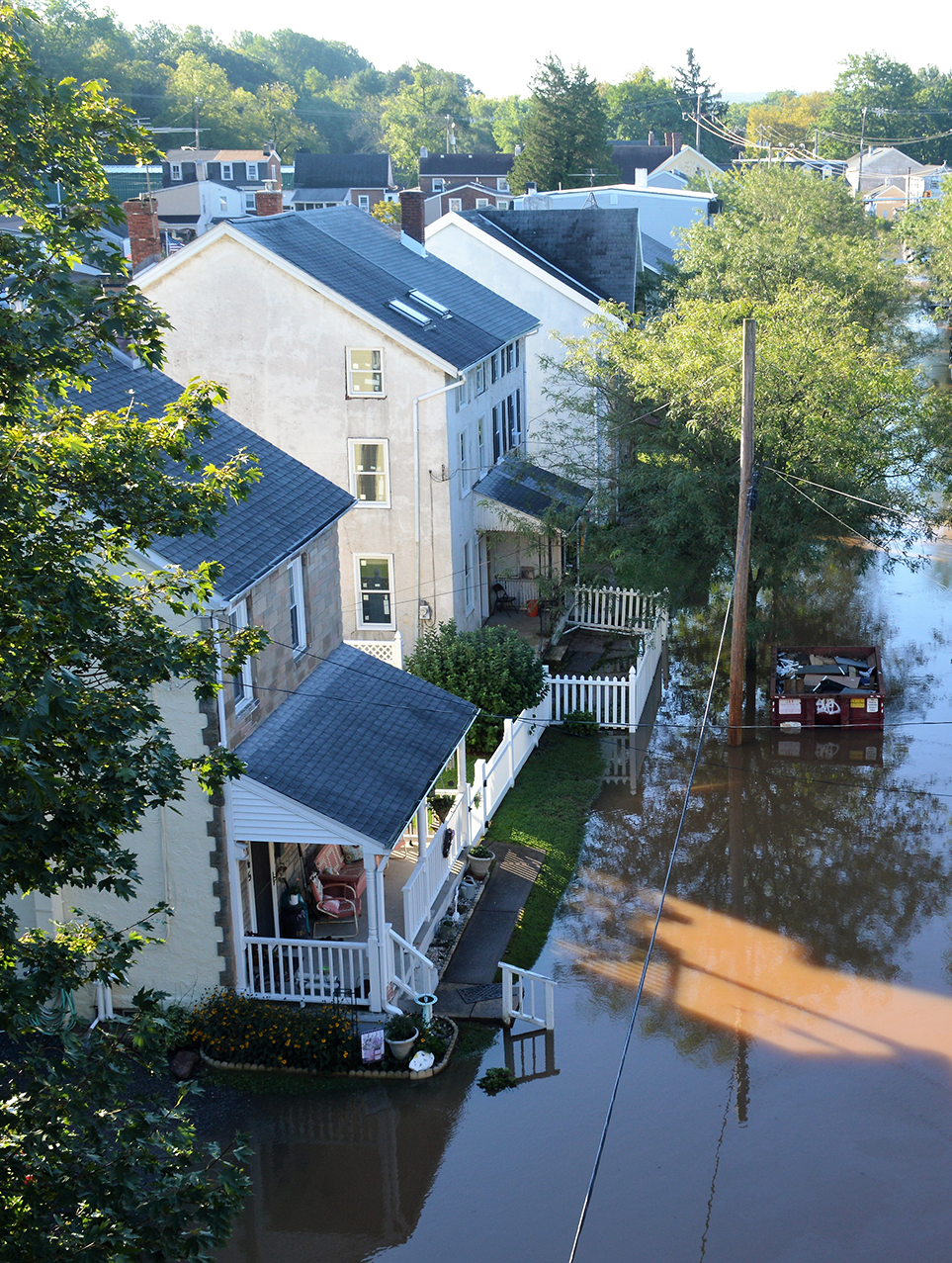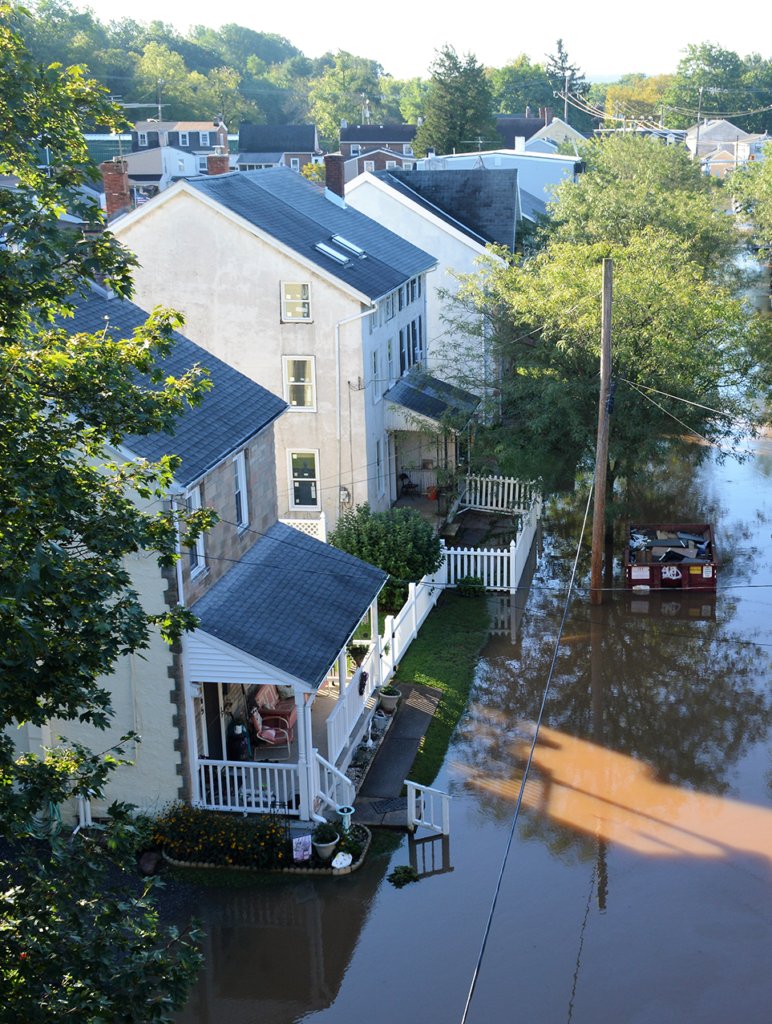When Tropical Storm Isaias hit the East Coast in early August 2020, the waters of Perkiomen Creek surged higher than 19 feet, a record for the waterway and eight feet beyond its flood stage. Homes situated along the creek on First Avenue in Collegeville, Montgomery County, bore the brunt of the flooding. But the Federal Emergency Management Agency (FEMA) didn’t offer the borough support with buyouts, so most opted not to move.
A year later, many Collegeville residents were just finishing the arduous task of cleaning up and putting their homes and lives back together when Hurricane Ida (by then a post-tropical cyclone) brought even more extreme rainfall to the region. It was estimated that the creek’s floodwaters crested at more than 26 feet — an estimate because the U.S. Geological Survey’s gauge maxes out at 20. This time, the response to the devastation was different.
By November 2021, two months after the floods, members of Collegeville’s municipal government met with homeowners — many of whom had been flooded several times in the preceding two decades — to offer a better solution.
“Living with that anxiety and fear every time they call for a big storm, that you’re going to lose your belongings or home or have to be rescued, is stressful,” Collegeville borough manager Tamara Twardowski says. “We thought the most prudent thing to do was to try to buy the properties out.”
Of the 22 homeowners who endured substantial damage by Ida, 20 agreed to sell their properties to the borough, which bought them with $6 million in FEMA funding.
After two months of demolition this spring, the long and winding process of flood buyouts reached its conclusion in Collegeville. Now, where homes once faced the threat of damage and destruction with each major rainfall, the stretch of land along the creek has been returned to open space, where plant life will flourish and serve as a buffer in the event of future floods. And future floods are sure to come.
To give people money to rebuild or give assistance to flood victims whose homes continue to flood every year seems like throwing money away. The most effective measure is to buy the property and let people go elsewhere.”
— Tamara Twardowski, Collegeville borough manager
More than 1,500 Pennsylvania homes were acquired and demolished using FEMA funds between 1994 and 2021, according to a review of the agency’s data. Of those, 27 were in Bucks County, 18 in Chester County, 60 in Delaware County and 159 in Montgomery County. Philadelphia, meanwhile, bought out two duplexes following Hurricane Floyd in 1999, according to Elaine Montes, the City’s program manager for flood resilience; the City has not conducted any buyouts since then.
As climate change contributes to rising sea levels and more extreme weather events, flood risk managers recognize property buyouts as an increasingly important tool to protect their communities — and the only mitigation strategy that completely eliminates a household’s flood risk.
“To give people money to rebuild or give assistance to flood victims whose homes continue to flood every year seems like throwing money away,” Twardowski says. “The most effective measure is to buy the property and let people go elsewhere.”
Not If, but When
There are four strategies to address flood risk, says A.R. Siders, director of the University of Delaware’s Climate Change Science and Policy Hub: resist (holding back water with floodwalls and levees); accommodate (elevating homes, for example); avoid (preventing new buildings being placed in floodplains); and retreat (relocating residents to safer homes). Buyouts represent the last of these and are the primary mechanism through which the United States deals with repetitive flood loss. Since 1989, FEMA has funded the acquisition of around 45,000 homes, pouring $4 billion into the program — accounting for the vast majority of the agency’s support for flood-prone properties.
In the case of a buyout, which requires a municipality to sponsor an application, a flood-prone home is purchased at a pre-flood valuation. Given the neighborhood scale of most floods, the median buyout includes 11 homes being addressed at once, Siders says. She’s in favor of scaling up relocation efforts, noting that it isn’t a question of if people in floodplains are going to have to move, but when.
“Insurance prices are rising, floods are getting worse, people want out and they don’t want to just sell and put a new family in the house in the same situation,” Siders says. “Making buyouts available is a really important part of giving people meaningful choices.”
The Pennsylvania Emergency Management Agency (PEMA) is working on 282 buyouts, primarily in the southeastern part of the state, thanks to nearly $120 million in combined funding from Ida and COVID-19 relief efforts, according to PEMA hazard mitigation officer Tom Hughes. It’s the most funding the agency has ever had for its mitigation programs, he says, and considering how often he and his colleagues hear about unusual flooding — either in terms of location or severity — demand will only continue to grow.
In Philadelphia, where Eastwick residents live in fear of Cobbs Creek overflowing with each heavy rainfall and Manayunk homes and businesses are at the mercy of the Schuylkill River, buyouts are part of the conversation but not yet being carried out. Housing stock is in part to blame, Montes says. Some 60% of the city’s houses are row houses, which complicates any thought of a buyout because of the challenges posed to neighbors’ structural integrity if a home is demolished.
Housing supply is another issue. As Hughes points out, homeowners in the rest of the state can more easily find a new home to move into. In Southeastern Pennsylvania, though, it’s not so simple. “In Philadelphia,” Montes says, “where do we put all the people?”
So while the surrounding counties have managed to buy out the homes at greatest risk of repeated flood damage — and neighboring New Jersey boasts one of the country’s foremost buyout programs — Philadelphia is still developing its plans to integrate buyouts into the broader suite of mitigation strategies.
“It’s not that we don’t have a buyout program in Philly because we don’t want to,” Montes says. “It’s because the tools and technical and financial support and availability are big roadblocks we’re grappling with.”

An Imperfect Solution
Even successful buyout programs have flaws, Siders says. Among them is the often insufficient money offered to relocating homeowners, whose home values are often depressed by virtue of being in a floodplain. The process also takes as long as five years; even the fastest buyouts take at least three to six months, Siders says. After a disaster occurs, a community must await a disaster declaration, then document the damage, compile paperwork at the state and federal levels, wait for their municipality to secure funding, then conduct appraisals and negotiations.
“It’s really difficult for residents waiting in limbo to decide whether to repair the home that was flooded and damaged,” Siders says. “Making that process faster is a really important issue.”
In Collegeville, half of the families affected by Ida never returned to their homes, which were rendered unlivable. Several rehabilitated their second floors enough to stay in place while the buyout process unfolded. One couple slept in a tent on their property for a period of time. Most waited at least 18 months before settlement, Twardowski says.
“It was a very upsetting time,” she says. “If they had mortgages, they still had to pay them or they would lose the house.”
Beyond all of the bureaucratic red tape that accompanies the buyout process, there are also social concerns that deserve attention, says Kevin Loughran, assistant professor of sociology at Temple University, who studies urban adaptation and environmental justice. Given that FEMA buyouts are entirely voluntary, many homeowners opt to stay in place and deal with continued flood risks.
“It’s an economic and engineering question when you’re talking about taking people’s property, taking them out of their communities,” Loughran says. “But a lot of people value being able to stay close to where they live, even in the midst of flooding.”

Offering a Lifeline
Across the Delware River, the New Jersey Department of Environmental Protection’s Blue Acres program offers a window into one possible future for flood buyouts. Since 1995, the program has used state and federal funding to buy out more than 1,100 homes, according to program manager Courtney Wald-Wittkop. Residents who apply for the program are assigned a case manager “to hold a homeowner’s hand throughout the process,” she says, supporting the equally complex financial and emotional aspects of a buyout. The majority of the program’s buyouts have come since 2012, when Hurricane Sandy destroyed thousands of homes. As flooding becomes more extreme, Wald-Wittkop says Blue Acres is looking to adapt.
“A large portion of our work has been responsive, but we know problems are getting worse,” she says. “How do we do it in a smarter, more strategic way? It requires not just looking at which homes are in the floodway but where we’re seeing people who’ve flooded out a couple times even in just the past year.”
Blue Acres is made effective by its consistent source of funding from both state and federal government, which means it doesn’t have to wait for a disaster to pursue buyouts, Siders says. It also has negotiating power with banks, sometimes securing lower mortgage rates to facilitate the purchase of a new home and motivate relocation, she says, as well as tighter timelines than other buyout programs. Notably, the program’s dedicated staff eliminates an obstacle faced in many communities: the reliance on overwhelmed local administrators to lead the process.
As flood risk mitigation becomes a pressing concern in Philadelphia and beyond, more effective and proactive buyout programs could be the key to keeping communities out of harm’s way, offering a solution to the fear and anxiety of life in a floodplain.
“These are options. These are tools,” Wald-Wittkop says. “We’re not — at least right now — saying to people, ‘You must go.’ We’re offering you a lifeline. We’re giving you a choice to get out of this situation.”









